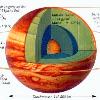

Tags: Jupiter View |
Jupiter Tags: Jupiter View |
??????? Jupiter jupiter Tags: Jupiter View |
|||||||||
Jupiter is the fifth planet from the Sun and the largest (Solar system by size) planet within the Solar System. It is a gas giant with a mass slightly less than one-thousandth of the Sun but is two and a half times the mass of all the other planets in our Solar System combined. Jupiter is classified as a gas giant along with Saturn, Uranus and Neptune. Together, these four planets are sometimes referred to as the Jovian (Wiktionary:Jovian) planets.
The planet was known by astronomers of ancient times and was associated with the mythology and religious beliefs of many cultures. The Romans (Ancient Rome) named the planet after the Roman god (Roman mythology) Jupiter (Jupiter (mythology)). When viewed from Earth, Jupiter can reach an apparent magnitude of −2.94, making it on average the third-brightest object in the night sky after the Moon and Venus. (Mars can briefly match Jupiters brightness at certain points (opposition (astronomy)) in its orbit.)
Jupiter is primarily composed of hydrogen with a quarter of its mass being helium; it may also have a rocky core of heavier elements. Because of its rapid rotation, Jupiters shape is that of an oblate spheroid (it possesses a slight but noticeable bulge around the equator). The outer atmosphere is visibly segregated into several bands at different latitudes, resulting in turbulence and storms along their interacting boundaries. A prominent result is the Great Red Spot, a giant storm that is known to have existed since at least the 17th century when it was first seen by telescope. Surrounding the planet is a faint planetary ring system and a powerful magnetosphere. There are also at least 63 moons, including the four large moons called the Galilean moons that were first discovered by Galileo Galilei in 1610. Ganymede (Ganymede (moon)), the largest of these moons, has a diameter greater than that of the planet Mercury (Mercury (planet)).
Jupiter has been explored on several occasions by robotic spacecraft, most notably during the early Pioneer (Pioneer program) and Voyager (Voyager program) flyby missions and later by the Galileo orbiter (Galileo (spacecraft)). The most recent probe to visit Jupiter was the Pluto-bound New Horizons spacecraft in late February 2007. The probe used the gravity (Gravitational slingshot) from Jupiter to increase its speed. Future targets for exploration in the Jovian system include the possible ice-covered liquid ocean on the moon Europa (Europa (moon)).
Symbol: Astronomical symbol of Jupiter (File:Jupiter symbol.svg)
Epoch: J2000
Aphelion: convert816520800kmAUabbr=on
Perihelion: convert740573600kmAUabbr=on
Semimajor: convert778547200kmAUabbr=on
Eccentricity: 0.048775
Inclination: 1.305� to Ecliptic,6.09� to Sun's equator,0.32� to Invariable plane
Asc Node: 100.492�
Arg Peri: 275.066�
Mean Anomaly: 18.818�
Period: 4,331.572 days,11.85920 yr (julian year (astronomy)),10,475.8 Jupiter solar dayscite weburl = = Rotation Period and Day Lengthlast = Seligman first = Courtneyaccessdate = 2009-08-13
Synodic Period: 398.88 days
Avg Speed: 13.07 km/s
Satellites: 63 (Jupiter's natural satellites)
Physical Characteristics: yes
Flattening: 0.06487 � 0.00015
Equatorial Radius: 71,492 � 4 km ,11.209 Earths
Polar Radius: 66,854 � 10 km ,10.517 Earths
Surface Area: 6.21796�1010 km�,121.9 Earths
Volume: 1.43128�1015 km� ,1321.3 Earths
Mass: 1.8986�1027 kg ,317.8 Earths,1/1047 Sun
Density: 1.326 g/cm�
Surface Grav: 24.79 m/s� (Acceleration),2.528 g (g-force)
Escape Velocity: 59.5 km/s
Sidereal Day: 9.925 h
Rot Velocity: 12.6 km/s,45,300 km/h
Axial Tilt: 3.13�
Right Asc North Pole: 268.057�,17 h 52 min 14 s
Declination: 64.496�
Albedo: 0.343 (bond (Bond albedo)), 0.52 (geom. (Geometric albedo))
Magnitude: -1.6 to -2.94
Angular Size: 29.8" ? 50.1"
Pronounce: IPAc-enen-us-Jupiter.ogg?d?u?p?t?r
Adjectives: Jovian
Temperatures: yes
Temp Name1: 1 bar level
Mean Temp 1: 165 K (Kelvin)
Temp Name2: 0.1 bar
Mean Temp 2: 112 K
Atmosphere: yes
Atmosphere Ref:
Surface Pressure: 20-200 kPa (Pascal (unit)) (cloud layer)
Scale Height: 27 km
Atmosphere Composition: 89.8�2.0%Hydrogen (H2) 10.2�2.0%Helium ~0.3%Methane ~0.026%Ammonia ~0.003%Hydrogen deuteride (HD) 0.0006%Ethane 0.0004%water Ices: Ammonia water ammonium hydrosulfide(NH4SH)



